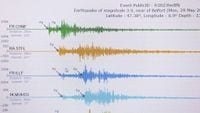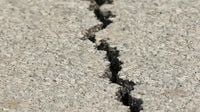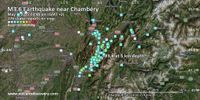On the morning of May 6, 2025, a magnitude 3.6 earthquake shook the Grésivaudan region, with its epicenter located in Sainte-Marie-d'Alloix, just a few kilometers north of Grenoble. The quake struck at approximately 3:40 AM and lasted around 20 seconds, startling many residents in the area.
According to the European-Mediterranean Seismological Centre, the tremor was felt across a wide area, reaching as far as Chambéry, where some locals reported experiencing a "loud boom" or a "dull rumble" during the shaking. Despite the noticeable seismic activity, authorities were quick to reassure the public that no significant damage or injuries had occurred.
Firefighters in the Savoie department confirmed that they received no calls related to the earthquake, indicating that the event did not necessitate any emergency interventions. This lack of incidents was echoed by reports from the Bureau Central Sismologique Français, which also noted the quake's moderate magnitude.
The earthquake's impact was felt in various municipalities, including Chambéry, Saint-Baldolph, and Argentine. Many residents were startled awake, particularly those with pets who seemed to sense the tremor before their human counterparts. The quake was classified as weak to moderate on the Richter scale, which typically corresponds to seismic activity that can be felt by the population but rarely causes serious damage.
In the wake of the earthquake, local authorities emphasized the importance of preparedness for such natural events, as they can occur with little warning. Experts remind residents that while a magnitude 3.6 earthquake is generally not dangerous, it serves as a reminder of the seismic activity that can affect the region.
Interestingly, this earthquake comes on the heels of a previous environmental concern in the area. In 2024, two samples taken from the Grand Chambéry drinking water network revealed the presence of per- and polyfluoroalkyl substances (PFAS), which are known as "forever chemicals" due to their persistence in the environment. These pollutants were detected in several towns, including Jacob-Bellecombette, Chambéry, Cognin, Saint-Baldoph, Barberaz, La Ravoire, and Montagnole. In response, local officials announced plans to implement an action plan to address the contamination.
As the region continues to grapple with these challenges, the earthquake serves as a reminder of the natural forces at play in the area. Many residents are left contemplating the balance between living in a beautiful but geologically active region and the potential risks that come with it.
In conclusion, while the earthquake was unsettling for many, it thankfully resulted in no injuries or significant damage. As the community moves forward, the focus will likely shift back to addressing the ongoing environmental issues while remaining vigilant about the seismic activity that is part of life in this picturesque part of France.






